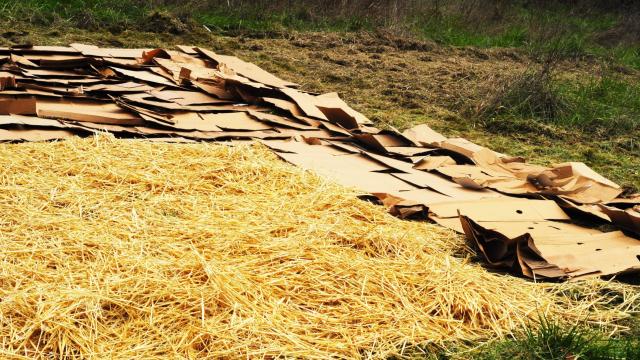Switching up your yard usually means ripping up the grass, tilling, and fertilising the soil to prep for new vegetation, but why not just cover it up? Sheet mulching uses a simple form of composting to repurpose your lawn by revitalising the soil and building nutrients for new plants. Using cardboard, green compost, and mulch, you can transform your lawn into a new ecosystem that conserves water and feeds plants naturally. Here’s how to sheet mulch your yard without in-depth landscaping.
What you need to sheet mulch a yard
Sheet mulching works like any other sort of composting — it uses the natural decomposition process to feed new growth. When a tree falls or leaves pile up, they break down and release nutrients into the soil for new life to thrive. Sheet mulching uses the composting process by covering existing grass with other organic materials that will decompose over time, creating a nutrient-rich soil. TikToker Brandon Gentry uses store-bought compost:
To successfully sheet mulch, you will need:
- Cardboard boxes, or rolls of recycled cardboard or newspaper
- Green compost (wood chips, leaves, plant clippings, hay)
- A hose (or water source)
- Organic mulch
Depending on the square meterage of the area you’re looking to reconstruct, you may need a large amount of cardboard, compost, and mulch. The majority of mulch is sold in cubic yards, so you’ll need to measure the area to determine how much you need.
How to sheet mulch your lawn
Before you get started, test your soil to find out its mineral makeup. The results will show any pre-existing issues or effects from prior soil treatments and help you make informed decisions for your lawn’s needs.
The sheet mulching process begins with prepping the area by removing dead bushes or plants so you have even ground to lay your cardboard or newspaper. Almost anything you remove can be used in the green compost layer. Use your hose or sprinkler to fully wet the grass, then lay down your cardboard or newspaper over the desired area making sure any tape, stickers, or other inorganic materials are removed from the boards. The cardboard should be overlapping by at least six inches, so weeds and grass don’t poke through. Take your hose again and thoroughly wet the cardboard. After the cardboard is soaked, spread your layer of organic green compost to cover the cardboard completely — you’ll want the compost layer to be at least two inches thick.
At this point, you can plant baby plants in the compost layer. As the plants grow, the roots will poke through the cardboard, and while the layer below decomposes, it’ll provide fortifying nutrients for the plants’ growth. Next, on top of the compost, put your desired mulch. This portion adds a layer of added moisture retention for the composting process below and reduces the amount of water your plants will need.

Leave a Reply
You must be logged in to post a comment.